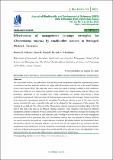Effectiveness of management (coping) strategies for Chromolaena odorata by smallholder farmers in Serengeti District, Tanzania

View/
Date
2021-08-30Author
Makere, Monica
Munishi, Linus
Ndakidemi, Patrick
Metadata
Show full item recordAbstract
The study aimed to assess the performance of farmer-led production practices adopted in maize farming systems to recommend the best adoption methods for coping with Chromolaena odorata, one of the world’s deadliest invasive alien species (IAS). The study also aims to make this adaptive strategy available so that smallholder farmers can readily use it to make better decisions on the effective use of land infested with this IAS for crop production, particularly in the Serengeti area, where communities are already experiencing a strong establishment and spread of this and other IAS.Field experiment was conducted in Serengeti District to test if the local community’s management practice for managing Chromolaena odorata as one of the major invasive species dominated the area is cost-effectively and can be adopted for the management of this invasive. The experiment was laid out. The setting up of the Chromolaena odorata management (weeding) plots in the trial sites of this study were done in six different weeding categories. These categories were based on informed management practices conducted by local communities in the Serengeti District as strategies for dealing with Chromolaena odorata infestation in their cultivated land. Weeding levels were used to test which management practice perform well in agricultural field with Chromolaena odorata. One way Analysis of Variance (ANOVA) was used to assess for the significant variation between treatments. The finding indicate that In treatment where Chromolaena odorata was managed well there was an increase of yield compared to the treatment with less management. Such adaptation is a crucial component of securing the invaded crop areas’ future food production in the face of global environmental change. These results should inform relevant sectors, and stakeholders of this important initiative and encourage collaboration for implementation in affected areas.
